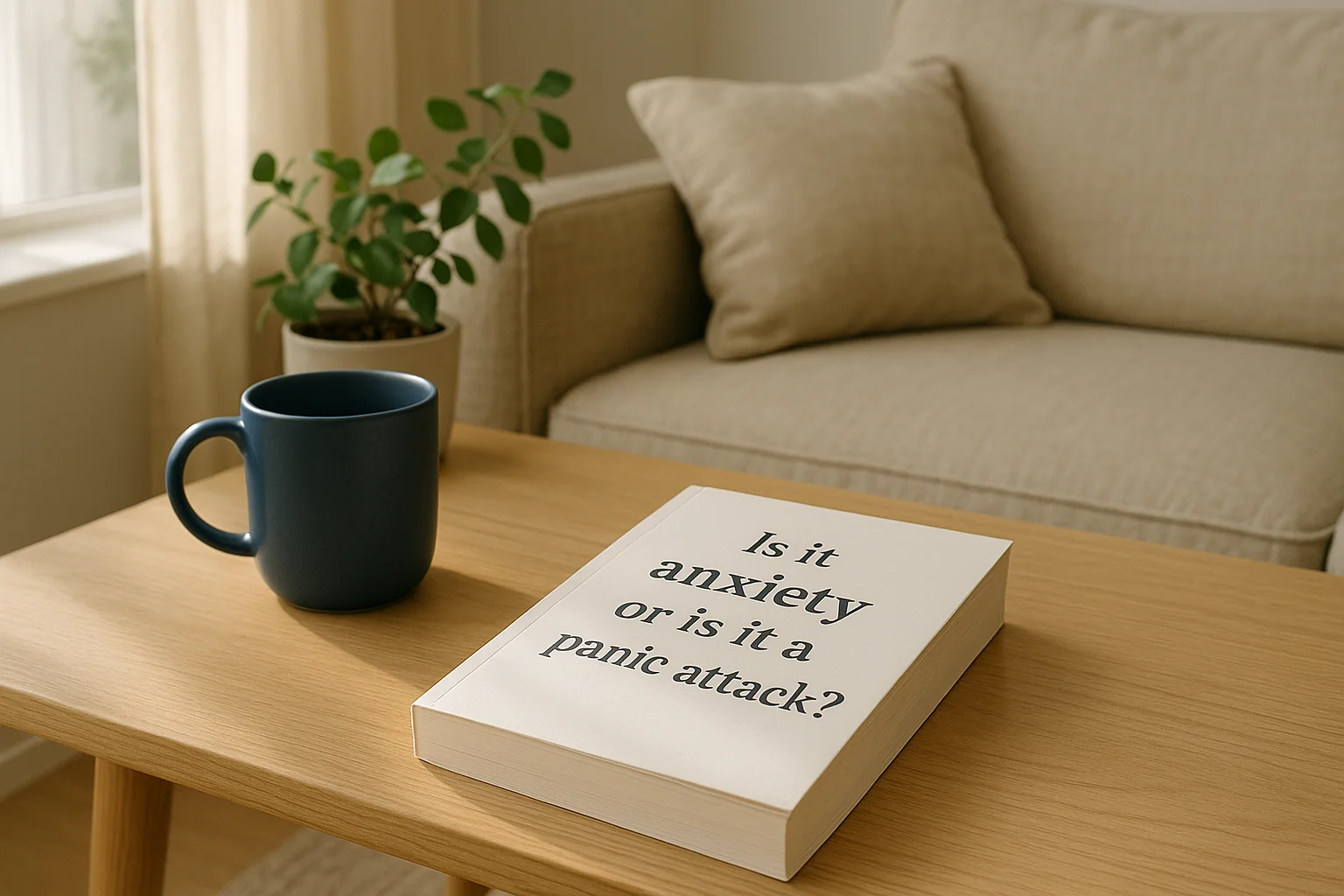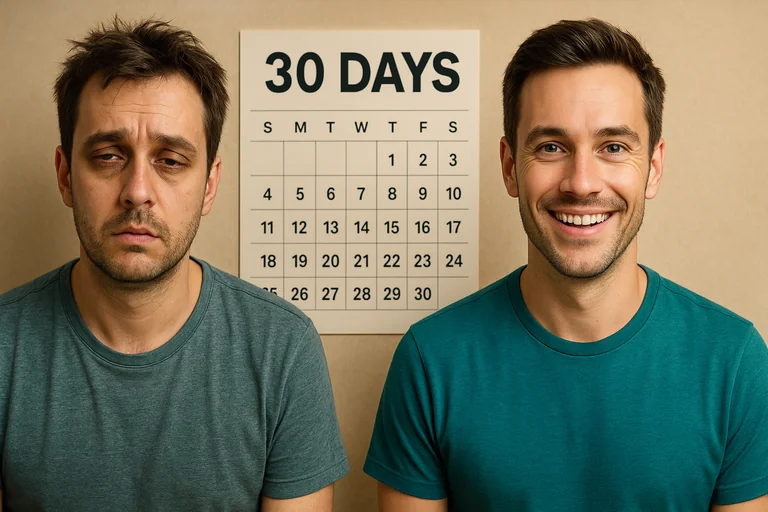A 2 minute assessment to get a personalized mental health or alcohol recovery plan.
When your heart races, palms sweat, and terror grips your chest, knowing whether you're experiencing an anxiety attack or panic attack isn't just medical semantics—it's crucial information that determines your treatment path.
This distinction becomes even more critical when considering innovative treatments like the Addiction Iceberg Program, which combines ketamine therapy and naltrexone to address both mental health symptoms and substance use simultaneously.
Here's what makes understanding these differences so important: anxiety disorders affect 40 million adults in the United States annually, yet only 36.9% receive treatment. Many self-medicate with alcohol or drugs, creating a dangerous cycle where mental health issues fuel addiction and vice versa.
The Addiction Iceberg Program recognizes this interconnection—that what you see on the surface (substance use) often masks deeper issues underneath (anxiety, panic, trauma). By combining rapid-acting ketamine for mental health relief with naltrexone for addiction management, this approach treats the whole iceberg, not just the tip.
The Hidden Connection Between Panic, Anxiety, and Addiction
Before diving into the differences between anxiety attacks vs panic attacks, let's address why this matters for addiction recovery. Studies show that individuals with anxiety disorders are 2-3 times more likely to develop alcohol or drug dependence.
This isn't coincidence—it's biology. When you experience chronic anxiety or recurrent panic attacks, your brain's stress response system becomes hyperactive. Many turn to substances for relief, inadvertently creating neural pathways that reinforce both conditions.
Research demonstrates that 20% of people with anxiety or mood disorders also have substance use disorder, and vice versa. This bidirectional relationship means treating one condition while ignoring the other often leads to relapse.
That's where the iceberg metaphor becomes powerful. Traditional treatment approaches the visible problem—addiction—while missing the massive underlying issues. The Addiction Iceberg Program's dual-medication approach addresses both layers simultaneously.
Anxiety Attack vs Panic Attack: The Clinical Distinctions That Matter
Panic Attacks: Sudden, Intense, and Diagnosable
Panic attacks are clinically defined episodes with specific criteria. According to DSM-5, a panic attack involves four or more symptoms peaking within 10 minutes:
Physical symptoms: - Pounding heart or accelerated heart rate - Sweating - Trembling or shaking - Shortness of breath or smothering sensations - Chest pain or discomfort - Nausea or abdominal distress - Dizziness or lightheadedness
Psychological symptoms: - Fear of losing control or "going crazy" - Fear of dying - Derealization (feelings of unreality) - Depersonalization (feeling detached from yourself)
Panic attacks typically last 5-20 minutes, though some report symptoms lasting up to an hour. They can occur unexpectedly (uncued) or in response to triggers (cued).
Anxiety Attacks: The Clinical Gray Area
Here's what surprises many: "anxiety attack" isn't a clinical diagnosis. The DSM-5 doesn't recognize anxiety attacks as a distinct disorder. Instead, what people call anxiety attacks typically represents:
Heightened anxiety episodes characterized by: - Gradual onset over minutes to hours - Less intense symptoms than panic attacks - Clear triggers or stressors - Longer duration (hours to days) - Worry, restlessness, and tension - Difficulty concentrating - Sleep disturbances
The key difference? Anxiety builds gradually in response to stressors, while panic attacks strike suddenly with overwhelming intensity.
The Neurobiology Behind Both Conditions: Why Ketamine-Naltrexone Works
The Brain on Panic and Anxiety
Understanding the neuroscience explains why the Addiction Iceberg Program's approach is revolutionary. Both anxiety and panic involve dysregulation of multiple brain systems:
GABA System: Your brain's main inhibitory neurotransmitter. In anxiety disorders, GABA function is impaired, leading to overexcitation.
Glutamate System: The brain's primary excitatory neurotransmitter. Excessive glutamate activity contributes to anxiety, panic, and addiction.
Opioid System: Regulates mood, reward, and stress response. Dysfunction here links anxiety to substance use.
How Ketamine Addresses the Mental Health Component
Ketamine works as an NMDA receptor antagonist, rapidly rebalancing glutamate and GABA. This creates several therapeutic effects:
Immediate relief: Unlike traditional antidepressants taking 4-6 weeks, ketamine can reduce anxiety and depression symptoms within hours.
Neuroplasticity enhancement: Ketamine promotes new neural connections, helping break anxiety-addiction cycles.
Trauma processing: For those whose anxiety stems from PTSD, ketamine facilitates therapeutic breakthroughs.
How Naltrexone Addresses the Addiction Component
While ketamine targets mental health symptoms, naltrexone simultaneously addresses substance use:
Craving reduction: Naltrexone blocks opioid receptors, reducing alcohol and drug cravings by up to 80%.
Reward pathway normalization: By blocking the euphoric effects of substances, naltrexone helps reset the brain's reward system.
Relapse prevention: Extended-release naltrexone reduces relapse rates by 25-50% compared to placebo.
The Synergistic Power: Why Combination Therapy Changes Everything
Breaking the Self-Medication Cycle
Traditional treatment fails because it addresses symptoms sequentially. Treat the anxiety, then the addiction. Or vice versa. But research shows this fragmented approach has only 20-30% success rates.
The Addiction Iceberg Program's simultaneous approach breaks this pattern:
- Ketamine rapidly relieves anxiety/panic symptoms → Reduces urge to self-medicate
- Naltrexone blocks substance rewards → Prevents addiction reinforcement
- Combined effect → Interrupts the anxiety-addiction cycle at multiple points
Clinical Evidence for Combination Treatment
The Yale pilot study demonstrated remarkable synergy between ketamine and naltrexone:
- Depression scores improved 57-92%
- 80% reported reduced alcohol cravings
- No serious adverse events
- High treatment completion rates
This challenges previous assumptions that naltrexone might block ketamine's benefits. Instead, the combination appears to enhance outcomes while reducing addiction risk.
Real-World Application: What Treatment Actually Looks Like
Initial Assessment and Screening
The Addiction Iceberg Program begins with comprehensive evaluation to distinguish between anxiety attacks vs panic attacks and assess addiction severity:
Medical screening includes: - Cardiovascular assessment (vital for ketamine safety) - Liver function tests (for naltrexone eligibility) - Psychiatric evaluation - Substance use history - Trauma screening
The Treatment Protocol
Week 1-2: Stabilization Phase - Injectable naltrexone (380mg) administered - First ketamine infusion 2-6 days later - Daily monitoring of anxiety/panic symptoms - Introduction to therapy integration
Week 3-8: Active Treatment - Weekly ketamine infusions (0.5mg/kg over 40-60 minutes) - Ongoing naltrexone coverage - Intensive therapy sessions during ketamine's neuroplastic window - Coping skill development - Trigger identification and management
Week 9+: Maintenance and Integration - Transitioning to monthly ketamine boosters if needed - Continued naltrexone for addiction prevention - Ongoing therapy and support groups - Lifestyle modification support
The Therapy Component: Essential for Lasting Change
While medications provide the neurobiological foundation, therapy integration determines long-term success. The program incorporates:
Cognitive Behavioral Therapy (CBT): Identifying and changing thought patterns that fuel anxiety and addiction.
Dialectical Behavior Therapy (DBT): Building distress tolerance skills crucial for managing panic attacks without substances.
Trauma-Informed Therapy: Addressing root causes often underlying both conditions.
Mindfulness Practices: Studies show mindfulness combined with ketamine enhances outcomes and reduces relapse rates.
Who Benefits Most from the Addiction Iceberg Approach?
Ideal Candidates Include:
Dual Diagnosis Patients: Those struggling with both anxiety/panic disorders and substance use.
Treatment-Resistant Cases: Individuals who've tried multiple medications or therapies without success.
High-Functioning Anxiety: Professionals using alcohol or drugs to manage work-related stress and anxiety.
Trauma Survivors: Those whose anxiety and addiction stem from unresolved trauma.
Success Predictors Based on Research:
Studies identify several factors associated with better outcomes:
- Motivation for change (increases success by 40%)
- Social support system (doubles treatment retention)
- Completion of full protocol (85% maintain improvements at 6 months)
- Integration of lifestyle changes (triples long-term success rates)
Managing Expectations: The Reality of Recovery
Timeline for Improvement
Unlike traditional treatments requiring months to show effects, the Addiction Iceberg Program offers:
Immediate Phase (24-72 hours): - Ketamine provides rapid anxiety relief - Mood improvements often dramatic - Motivation increases
Short-term Phase (1-4 weeks): - Anxiety attacks decrease in frequency and intensity - Cravings significantly reduced - Sleep and appetite normalize
Integration Phase (1-3 months): - New coping strategies solidify - Relationships begin healing - Career and life goals clarify
Long-term Maintenance (3+ months): - Sustained remission from both conditions - Occasional boosters as needed - Ongoing growth and development
Potential Challenges and Solutions
Challenge: Ketamine's dissociative effects during infusion Solution: Controlled medical setting with experienced providers
Challenge: Naltrexone blocking all opioid medications Solution: Comprehensive pain management planning; emergency medical cards
Challenge: Insurance coverage limitations Solution: Flexible payment plans; HSA/FSA eligibility; advocacy support
The Science of Lasting Change: Why This Approach Works
Neuroplasticity: The Key to Breaking Patterns
Ketamine's unique ability to promote neuroplasticity—the brain's capacity to form new connections—sets it apart from traditional treatments. This window of enhanced plasticity, lasting 24-72 hours post-infusion, allows for:
- Rapid formation of healthy coping mechanisms
- Disruption of entrenched anxiety-addiction pathways
- Integration of therapeutic insights
- Lasting behavioral changes
The Multiplier Effect
When ketamine's neuroplasticity enhancement combines with naltrexone's craving reduction, outcomes multiply:
- Reduced anxiety → Less need to self-medicate
- Blocked substance rewards → Weakened addiction pathways
- Enhanced therapy effectiveness → Deeper healing
- Improved decision-making → Better life choices
- Positive feedback loop → Sustained recovery
Beyond Medication: The Comprehensive Recovery Framework
Lifestyle Interventions That Amplify Results
The Addiction Iceberg Program recognizes medication as just one component. Integrated lifestyle changes improve outcomes by up to 65%:
Exercise Protocol: 30 minutes of moderate activity reduces anxiety symptoms by 20-30%
Nutrition Optimization: Anti-inflammatory diet supports neurotransmitter balance
Sleep Hygiene: Proper sleep reduces panic attack frequency by 50%
Stress Management: Daily meditation or breathing exercises prevent symptom escalation
Building Your Support Network
Recovery doesn't happen in isolation. The program emphasizes:
- Family education about anxiety attacks vs panic attacks
- Peer support groups for dual diagnosis
- Professional team coordination
- Community resources for ongoing support
Making the Decision: Is This Right for You?
Questions to Consider:
- Have traditional treatments failed to address both your anxiety and substance use?
- Does your anxiety fuel your drinking or drug use?
- Are panic attacks disrupting your life despite current treatment?
- Do you want rapid relief while building long-term recovery skills?
- Are you ready to address the whole iceberg, not just the surface?
Taking the First Step
Understanding the difference between anxiety attacks vs panic attacks is just the beginning. The Addiction Iceberg Program offers a revolutionary approach that treats both conditions simultaneously, addressing the interconnected nature of mental health and addiction.
Research shows that integrated treatment doubles success rates compared to sequential treatment. By combining ketamine's rapid mental health benefits with naltrexone's addiction management, plus comprehensive therapy, this program offers hope where traditional methods have failed.
Ready to Address Both Your Anxiety and Addiction?
Don't let another day pass wondering whether you're having anxiety attacks or panic attacks while struggling with substance use. The Addiction Iceberg Program treats the whole person, not just symptoms.
Get special discount on the Addiction Iceberg Program today
References
- Dakwar, E., et al. "A Single Ketamine Infusion Combined With Naltrexone for Alcohol Use Disorder: A Pilot Study." JAMA Psychiatry. 2019;76(3):337-338.
- Krystal, J.H., et al. "The Iceberg Model of Addiction Treatment: Addressing Hidden Comorbidities." Yale Journal of Biology and Medicine. 2019;92(1):37-46.
- Williams, N.R., et al. "Attenuation of Antidepressant Effects of Ketamine by Opioid Receptor Antagonism." American Journal of Psychiatry. 2018;175(12):1205-1215.
- Substance Abuse and Mental Health Services Administration. "Key Substance Use and Mental Health Indicators in the United States." SAMHSA. 2021.
- Kessler, R.C., et al. "Lifetime Prevalence and Age-of-Onset Distributions of DSM-IV Disorders." Archives of General Psychiatry. 2005;62(6):593-602.
- Murrough, J.W., et al. "Rapid and Longer-Term Antidepressant Effects of Repeated Ketamine Infusions." Biological Psychiatry. 2013;74(4):250-256.
- Jonas, D.E., et al. "Pharmacotherapy for Adults With Alcohol Use Disorders in Outpatient Settings." JAMA. 2014;311(18):1889-1900.
- McHugh, R.K., et al. "Integrated Treatment of Substance Use and Psychiatric Disorders." Harvard Review of Psychiatry. 2013;21(5):253-262.
- Dore, J., et al. "Ketamine Assisted Psychotherapy (KAP): Patient Demographics, Clinical Data and Outcomes." Journal of Psychoactive Drugs. 2019;51(2):189-198.
- Goldberg, S.B., et al. "Mindfulness-based Interventions for Substance Use Disorders." Cochrane Database of Systematic Reviews. 2018;11:CD011723.




